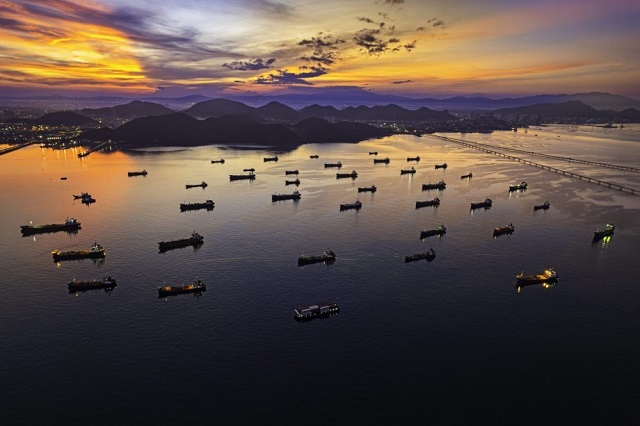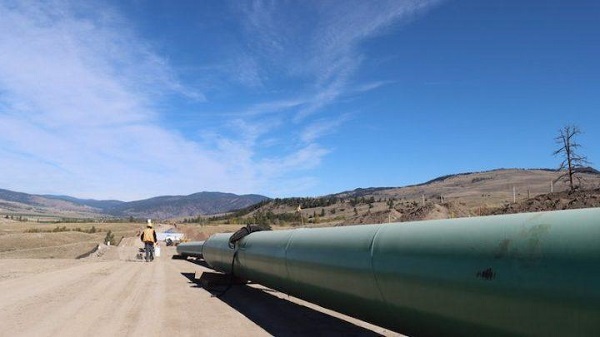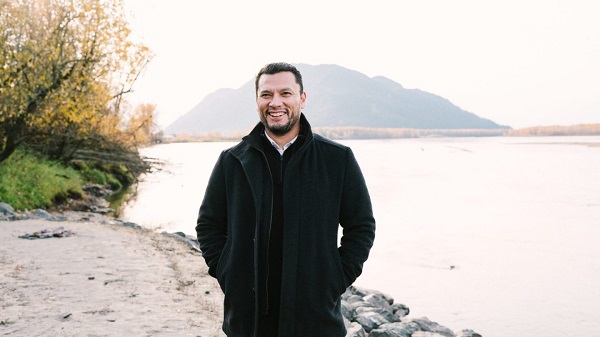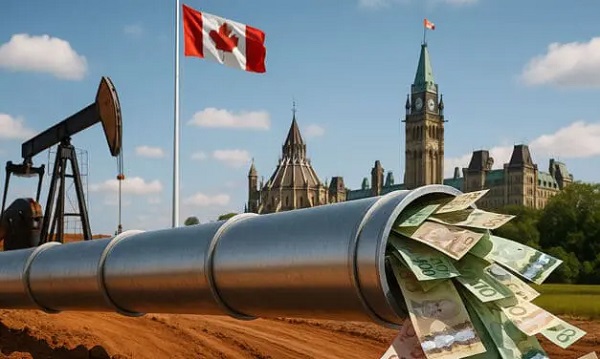Canadian Energy Centre
Energy year in review 2023: The world doubles down on energy security and reliability

From the Canadian Energy Centre
By Shawn Logan
As global demand for oil and gas surges, pragmatism returns to the energy discussion
Faced with soaring costs that rippled across economies, governments around the world embraced the critical need for energy security in 2023, adopting a more pragmatic approach to achieving climate goals.
The world used more crude oil and coal in 2023 than anytime in human history, while global demand for liquefied natural gas (LNG) continued to grow as a vital fuel source, primarily in Europe and Asia.
Europe in particular stepped back from some of its more aggressive timelines for reducing its reliance on oil and gas, with some nations striking long-term supply deals for LNG, returning to burning coal, or renewing investment in oil and gas exploration.
Economic powerhouses China and India increasingly turned to coal to power their developing economies, spurring global growth of the most emissions-intensive fuel, while the U.S. maintained its lead as the world’s largest producer of oil and gas, setting new high water marks for both.
Canada, meanwhile, saw steady progress on some key energy projects, completing construction of the Coastal GasLink pipeline, achieving major milestones on the LNG Canda export terminal, seeing the Trans Mountain pipeline expansion near completion, and the approval of a new major oil sands project for the first time in five years.
The following is a recap of some of the key events from 2023, outlining how oil and gas have once again taken centre stage in the aftermath of Russia’s 2022 invasion of Ukraine, and the global energy crisis that it made worse:
January
- Japanese Prime Minister Fumio Kishida visits Canada to make a personal appeal for more access to LNG. Like German Chancellor Olaf Scholz just five months earlier, Kishida is essentially rebuffed by Prime Minister Justin Trudeau.
- The International Energy Agency predicts that global oil demand will reach a record high in 2023, an increase of 1.9 million barrels per day from 2022’s previous peak.
- With LNG emerging as a critical resource to deal with the lingering global energy crisis, the United States catches up to Qatar as the world’s largest exporter.
 Prime Minister of Japan Fumio Kishida speaks during the G7 summit at Schloss Elmau, Germany on June 26, 2022 as (L-R) Canadian Prime Minister Justin Trudeau and German Chancellor Olaf Schulz look on. Getty Images photo
Prime Minister of Japan Fumio Kishida speaks during the G7 summit at Schloss Elmau, Germany on June 26, 2022 as (L-R) Canadian Prime Minister Justin Trudeau and German Chancellor Olaf Schulz look on. Getty Images photo
February
- India’s Prime Minister Narendra Modi projects his country will see demand for natural gas rise by 500 per cent while its share of global oil demand will increase from 5 to 11 per cent over the next 20 years. Meanwhile, India begins the search for long-term suppliers of LNG in an effort to reduce its reliance on coal.
- The bill for the 2022 energy crisis comes due in Europe, where it’s learned European governments shelled out nearly US$900 billion to shield households and businesses from its impacts. Germany, which was a world leader in transitioning to renewable energy led the way in efforts to blunt the energy crisis’ impact, handing out nearly US$300 billion in subsidies.
- Recognizing the rising global importance of reliable energy, Canadian oil producer IPC greenlights the first major new oil sands project in five years. The C$1.1 billion Blackrod project, which will be built to produce 30,000 barrels per day, is expected to be in operation by 2026. Meanwhile, Cenovus Energy filed an application to extend production at its Christina Lake oil sands project to 2079.
 Remo Benzi, owner of the Hop brewery lights candles for the candlelit dinner at “Hop-Mangiare di Birra” restaurant and brewery on October 4, 2022 in Alessandria, Italy. Every Tuesday evening, since a month, the restaurant turns off the lights and lights the candles as a reaction to the high energy prices. The Italian Business Confederation estimates that nearly 120,000 companies are threatened with bankruptcy due to energy price hikes. Getty Images photo
Remo Benzi, owner of the Hop brewery lights candles for the candlelit dinner at “Hop-Mangiare di Birra” restaurant and brewery on October 4, 2022 in Alessandria, Italy. Every Tuesday evening, since a month, the restaurant turns off the lights and lights the candles as a reaction to the high energy prices. The Italian Business Confederation estimates that nearly 120,000 companies are threatened with bankruptcy due to energy price hikes. Getty Images photo
March
- China shows signs of economic resurgence after re-opening from its sweeping “zero-Covid” policies. The IEA projects China will account for nearly half of all projected growth in oil demand in 2023.
- In the U.S., the Biden Administration approves a massive new oil project in Alaska, expected to produce as much as 180,000 barrels per day of crude oil over the course of 30 years. The project is also estimated to create some $17 billion in revenue for the U.S. federal government.
- A new report by the UK-based Energy Transitions Commission finds that global investments in green energy would need to increase to $3.5 trillion per year in order to reach global net zero targets by 2050. That would add up to $110 trillion in new spending by 2050, more than the world’s current combined GDP.
 A man walks towards a ferry as the Wujing coal-electricity power station is seen across the Huangpu River in the Minhang district of Shanghai. Getty Images photo
A man walks towards a ferry as the Wujing coal-electricity power station is seen across the Huangpu River in the Minhang district of Shanghai. Getty Images photo
April
- Indigenous leaders involved in Canada’s energy industry meet with diplomats from several of Canada’s G7 allies to make the case for being at the table when it comes to helping provide the energy the world needs. With Indigenous communities playing crucial roles in developing Canada’s LNG capacity, participants said diplomats showed significant interest in building economic relationships.
- Leaders of the G7 meet in Hiroshima, Japan and agree that LNG will play an “important role” in helping navigate the global energy crisis and further investment in the industry is crucial. Despite pressure to agree to a full phase out of coal by 2030, the G7 will only agree to “accelerating the phase out of domestic unabated coal.”
- A global survey that polled over 24,000 people in 28 countries found that Canada was the number one choice for countries that import oil, citing Canada’s strong record of democracy and environmental safety compared to other major producers like Saudi Arabia and Russia.
 Indigenous leaders meet with U.S. ambassador to Canada David Cohen. Photo courtesy Energy for a Secure Future
Indigenous leaders meet with U.S. ambassador to Canada David Cohen. Photo courtesy Energy for a Secure Future
May
- Recognizing the growing need for energy security across Europe and the world, Norway says oil and gas companies have a “social responsibility” to find more oil and natural gas resources in the northern Barents Sea adding they should “leave no stone unturned” in the pursuit of the critical resources. A month later Norway approves $18.5 billion to develop 19 offshore oil and gas projects.
- Skyrocketing demand for oil, led primarily by China’s economic surge, forces the IEA to recalculate its predictions for the year, upgrading its demand growth estimate to 2.2 million barrels per day to further increase record usage around the world.
- Canada’s Public Policy Forum estimates phasing out the country’s oil and gas industry in an effort to reduce emissions will lead to the loss of some $100 billion to the nation’s economy by 2050, with Alberta bearing the brunt of the blow. “This essentially amounts to a deep recession without a recovery ever materializing,” the authors wrote.
 Norway Minister of Petroleum and Energy Terje Assland and Equinor vice-president Grete B. Haaland at the official reopening of the Njord field on May 15th, 2023. Photo courtesy Equinor
Norway Minister of Petroleum and Energy Terje Assland and Equinor vice-president Grete B. Haaland at the official reopening of the Njord field on May 15th, 2023. Photo courtesy Equinor
June
- Qatar signs the first of several long-term LNG deals it will sign in 2023. Staring with two 27-year agreements to supply China with LNG, the Middle East supplier then signs another 15-year agreement with energy-starved Bangladesh.
- Despite Western sanctions, Russian oil companies see gasoline exports jump 37 per cent compared to 2022 thanks to new customers in Africa and Asia. Meanwhile, China’s crude oil imports from Russia soar to a record high.
- The annual Statistical Review of World Energy shows that record increases in solar and wind installations in 2022 failed to make a dent in the dominance of oil and gas in the global energy mix. Even with a record increase of 266 gigawatts of new renewable capacity, oil,gas and coal continued to represent 82 per cent of global energy consumption.
 Qatar Minister of State for Energy Affairs and QatarEnergy CEO Saad Sherida Al-Kaabi tours sites related to the North Field East project in March 2023. Photo courtesy QatarGas
Qatar Minister of State for Energy Affairs and QatarEnergy CEO Saad Sherida Al-Kaabi tours sites related to the North Field East project in March 2023. Photo courtesy QatarGas
July
- The U.K. announces it will grant hundreds of new licences for oil and gas exploration in the North Sea in an effort to ensure energy security. Prime Minister Rishi Sunak says even if the U.K. achieves net zero by 2050, oil and gas will still be used for at least a quarter of its energy needs.
- Japan, one of the world’s largest energy importers, calls for the creation of a global emergency reserve for natural gas to avoid future shortages and price spikes.
- With rising global demand for LNG, the CEO of QatarEnergy predicts the tiny Middle Eastern nation will supply some 40 per cent of new LNG coming to market by 2029 as the U.S. works to significantly ramp up its industry.
 A liquefied natural gas (LNG) tanker in Japan’s Tokyo Bay. Getty Images photo
A liquefied natural gas (LNG) tanker in Japan’s Tokyo Bay. Getty Images photo
August
- Independent researchers announce that China continues to ramp up coal power use, permitting 52 gigawatts of new capacity over the first six months of 2023. The additional plants would increase China’s coal burning capacity by 23 per cent.
- Independent analysis by S&P Global finds that Canada’s oil sands emissions remained flat in 2022, despite production growth, a positive sign that measures to reduce emissions are working.
- For the second year in a row, Pakistan is forced out of the pricey LNG market, putting the impoverished country at high risk of a national energy crisis.
 Workers at the Sunrise oil sands project in northern Alberta. Photo courtesy BP
Workers at the Sunrise oil sands project in northern Alberta. Photo courtesy BP
September
- Meeting in India, leaders of the G20 highlight the importance of energy security, and while agreeing to triple renewable capacity by 2030 avoid any language calling for a phase out of fossil fuels. Fault lines emerge between the West and developing nations that want to harness oil, natural gas and coal to grow their economies.
- The IEA releases its updated road map for reaching net zero, suggesting global demand for fossil fuels will peak before 2030. The stance is blasted by OPEC as one that could lead to global “energy chaos” and ignores the IEA’s own acknowledgement that one the world’s current trajectory, oil, gas and coal will still account for 62 per cent of the world’s energy mix in 2050, compared to 78 per cent in 2021.
- Saudi Aramco, one of the world’s largest oil producers, announces its intention to enter the burgeoning LNG industry, buying a minority stake in MidOcean Energy, which is looking to obtain stakes in four Australian LNG projects.
 A natural gas processing plant in Saudi Arabia. Photo courtesy Saudi Aramco
A natural gas processing plant in Saudi Arabia. Photo courtesy Saudi Aramco
October
- Qatar officially breaks ground on the world’s largest LNG project, which will expand its production capacity from 77 million tonnes per year to 110 million tonnes per year. The groundbreaking coincides with three new 27-year LNG supply agreements with France, Italy and the Netherlands.
- In its annual World Oil Outlook, OPEC warns the world will need $14 trillion in new investments in the oil sector by 2045 to ensure market stability and reduce the likelihood of energy shortages and economic chaos.
- The U.S. eases sanctions on Venezuela’s oil sector in exchange for the promise of free and fair elections for the South American dictatorship. Less than two weeks later, Venezuela’s supreme court suspends the results of an opposition party’s primary ahead of a 2024 national election.
 View of the “Peace Monument” sculpture outside the headquarters of Venezuelan state-owned oil company PDVSA, in Caracas. Getty Images photo
View of the “Peace Monument” sculpture outside the headquarters of Venezuelan state-owned oil company PDVSA, in Caracas. Getty Images photo
November
- Three years after shovels first hit the ground, TC Energy announces it has reached mechanical completion of the Coastal GasLink pipeline. The 670-kilometre will be a critical piece of infrastructure for Canada’s developing LNG industry.
- Despite its earlier World Energy Outlook suggesting a looming peak for oil demand, the IEA revises its prediction for 2024, estimating global demand for oil will reach a new record high of 102.9 million barrels per day next year. A more bullish OPEC predicts oil demand will reach 104.4 million barrels per day in 2024.
- The U.K. government says it’s working toward legislation that would make annual oil and gas licensing rounds for the North Sea mandatory if the country is set to import more oil and gas than it produces domestically.
 Coastal GasLink has surpassed 60 per cent overall project completion. Photo courtesy Coastal GasLink
Coastal GasLink has surpassed 60 per cent overall project completion. Photo courtesy Coastal GasLink
December
- World leaders leave COP28 in Dubai agreeing to eventually transition away from fossil fuels, aiming to reach carbon neutrality by 2050. But a key inclusion calls for the acceleration of low- and zero-emission technology like carbon capture and storage, an innovation in which Canada is a global leader.
- Fresh off the U.S. lifting sanctions on its oil industry, Venezuela claims sovereignty over an oil-rich region of neighbouring Guyana – accounting for about two-thirds of its territory – after ignoring ongoing proceedings in the International Court of Justice to settle the long-standing dispute.
- Russia says its crude oil exports will be seven per cent higher than in 2021 despite ongoing sanctions from the West. After losing most of its European customers, Russia reports that China and India now account for more than 90 per cent of its crude oil exports.
 Russian President Vladimir Putin and executives with state oil company Rosneft present a major shipbuilding complex to Indian Prime Minister Narendra Modi. India will be an investor in a new US$157 billion oil project in the Russian Arctic. Photograph courtesy Rosneft
Russian President Vladimir Putin and executives with state oil company Rosneft present a major shipbuilding complex to Indian Prime Minister Narendra Modi. India will be an investor in a new US$157 billion oil project in the Russian Arctic. Photograph courtesy Rosneft
Canadian Energy Centre
Cross-Canada economic benefits of the proposed Northern Gateway Pipeline project

From the Canadian Energy Centre
Billions in government revenue and thousands of jobs across provinces
Announced in 2006, the Northern Gateway project would have built twin pipelines between Bruderheim, Alta. and a marine terminal at Kitimat, B.C.
One pipeline would export 525,000 barrels per day of heavy oil from Alberta to tidewater markets. The other would import 193,000 barrels per day of condensate to Alberta to dilute heavy oil for pipeline transportation.
The project would have generated significant economic benefits across Canada.

The following projections are drawn from the report Public Interest Benefits of the Northern Gateway Project (Wright Mansell Research Ltd., July 2012), which was submitted as reply evidence during the regulatory process.
Financial figures have been adjusted to 2025 dollars using the Bank of Canada’s Inflation Calculator, with $1.00 in 2012 equivalent to $1.34 in 2025.
Total Government Revenue by Region
Between 2019 and 2048, a period encompassing both construction and operations, the Northern Gateway project was projected to generate the following total government revenues by region (direct, indirect and induced):

British Columbia
- Provincial government revenue: $11.5 billion
- Federal government revenue: $8.9 billion
- Total: $20.4 billion
Alberta
- Provincial government revenue: $49.4 billion
- Federal government revenue: $41.5 billion
- Total: $90.9 billion
Ontario
- Provincial government revenue: $1.7 billion
- Federal government revenue: $2.7 billion
- Total: $4.4 billion
Quebec
- Provincial government revenue: $746 million
- Federal government revenue: $541 million
- Total: $1.29 billion
Saskatchewan
- Provincial government revenue: $6.9 billion
- Federal government revenue: $4.4 billion
- Total: $11.3 billion
Other
- Provincial government revenue: $1.9 billion
- Federal government revenue: $1.4 billion
- Total: $3.3 billion
Canada
- Provincial government revenue: $72.1 billion
- Federal government revenue: $59.4 billion
- Total: $131.7 billion
Annual Government Revenue by Region
Over the period 2019 and 2048, the Northern Gateway project was projected to generate the following annual government revenues by region (direct, indirect and induced):

British Columbia
- Provincial government revenue: $340 million
- Federal government revenue: $261 million
- Total: $601 million per year
Alberta
- Provincial government revenue: $1.5 billion
- Federal government revenue: $1.2 billion
- Total: $2.7 billion per year
Ontario
- Provincial government revenue: $51 million
- Federal government revenue: $79 million
- Total: $130 million per year
Quebec
- Provincial government revenue: $21 million
- Federal government revenue: $16 million
- Total: $37 million per year
Saskatchewan
- Provincial government revenue: $204 million
- Federal government revenue: $129 million
- Total: $333 million per year
Other
- Provincial government revenue: $58 million
- Federal government revenue: $40 million
- Total: $98 million per year
Canada
- Provincial government revenue: $2.1 billion
- Federal government revenue: $1.7 billion
- Total: $3.8 billion per year
Employment by Region
Over the period 2019 to 2048, the Northern Gateway Pipeline was projected to generate the following direct, indirect and induced full-time equivalent (FTE) jobs by region:

British Columbia
- Annual average: 7,736
- Total over the period: 224,344
Alberta
- Annual average: 11,798
- Total over the period: 342,142
Ontario
- Annual average: 3,061
- Total over the period: 88,769
Quebec
- Annual average: 1,003
- Total over the period: 29,087
Saskatchewan
- Annual average: 2,127
- Total over the period: 61,683
Other
- Annual average: 953
- Total over the period: 27,637
Canada
- Annual average: 26,678
- Total over the period: 773,662
Business
Natural gas pipeline ownership spreads across 36 First Nations in B.C.

Chief David Jimmie is president of Stonlasec8 and Chief of Squiala First Nation in B.C. He also chairs the Western Indigenous Pipeline Group. Photo courtesy Western Indigenous Pipeline Group
From the Canadian Energy Centre
Stonlasec8 agreement is Canada’s first federal Indigenous loan guarantee
The first federally backed Indigenous loan guarantee paves the way for increased prosperity for 36 First Nations communities in British Columbia.
In May, Canada Development Investment Corporation (CDEV) announced a $400 million backstop for the consortium to jointly purchase 12.5 per cent ownership of Enbridge’s Westcoast natural gas pipeline system for $712 million.
In the works for two years, the deal redefines long-standing relationships around a pipeline that has been in operation for generations.
“For 65 years, there’s never been an opportunity or a conversation about participating in an asset that’s come through the territory,” said Chief David Jimmie of the Squiala First Nation near Vancouver, B.C.
“We now have an opportunity to have our Nation’s voices heard directly when we have concerns and our partners are willing to listen.”
Jimmie chairs the Stonlasec8 Indigenous Alliance, which represents the communities buying into the Enbridge system.
The name Stonlasec8 reflects the different regions represented in the agreement, he said.
The Westcoast pipeline stretches more than 2,900 kilometres from northeast B.C. near the Alberta border to the Canada-U.S. border near Bellingham, Wash., running through the middle of the province.

It delivers up to 3.6 billion cubic feet per day of natural gas throughout B.C. and the Lower Mainland, Alberta and the U.S. Pacific Northwest.
“While we see the benefits back to communities, we are still reminded of our responsibility to the land, air and water so it is important to think of reinvestment opportunities in alternative energy sources and how we can offset the carbon footprint,” Jimmie said.
He also chairs the Western Indigenous Pipeline Group (WIPG), a coalition of First Nations communities working in partnership with Pembina Pipeline to secure an ownership stake in the newly expanded Trans Mountain pipeline system.
There is overlap between the communities in the two groups, he said.
CDEV vice-president Sébastien Labelle said provincial models such as the Alberta Indigenous Opportunities Corporation (AIOC) and Ontario’s Indigenous Opportunities Financing Program helped bring the federal government’s version of the loan guarantee to life.
“It’s not a new idea. Alberta started it before us, and Ontario,” Labelle said.
“We hired some of the same advisors AIOC hired because we want to make sure we are aligned with the market. We didn’t want to start something completely new.”
Broadly, Jimmie said the Stonlasec8 agreement will provide sustained funding for investments like housing, infrastructure, environmental stewardship and cultural preservation. But it’s up to the individual communities how to spend the ongoing proceeds.
The long-term cash injections from owning equity stakes of major projects can provide benefits that traditional funding agreements with the federal government do not, he said.
Labelle said the goal is to ensure Indigenous communities benefit from projects on their traditional territories.
“There’s a lot of intangible, indirect things that I think are hugely important from an economic perspective,” he said.
“You are improving the relationship with pipeline companies, you are improving social license to do projects like this.”
Jimmie stressed the impact the collaborative atmosphere of the negotiations had on the success of the Stonlasec8 agreement.
“It takes true collaboration to reach a successful partnership, which doesn’t always happen. And from the Nation representation, the sophistication of the group was one of the best I’ve ever worked with.”
-

 Canadian Energy Centre2 days ago
Canadian Energy Centre2 days agoCross-Canada economic benefits of the proposed Northern Gateway Pipeline project
-

 Alberta2 days ago
Alberta2 days agoAlbertans need clarity on prime minister’s incoherent energy policy
-

 conflict22 hours ago
conflict22 hours ago“Evacuate”: Netanyahu Warns Tehran as Israel Expands Strikes on Iran’s Military Command
-

 Health1 day ago
Health1 day agoLast day and last chance to win this dream home! Support the 2025 Red Deer Hospital Lottery before midnight!
-

 Energy21 hours ago
Energy21 hours agoCould the G7 Summit in Alberta be a historic moment for Canadian energy?
-

 Alberta1 day ago
Alberta1 day agoAlberta’s grand bargain with Canada includes a new pipeline to Prince Rupert
-

 Crime2 days ago
Crime2 days agoManhunt on for suspect in shooting deaths of Minnesota House speaker, husband
-

 Business2 days ago
Business2 days agoCarney’s European pivot could quietly reshape Canada’s sovereignty






